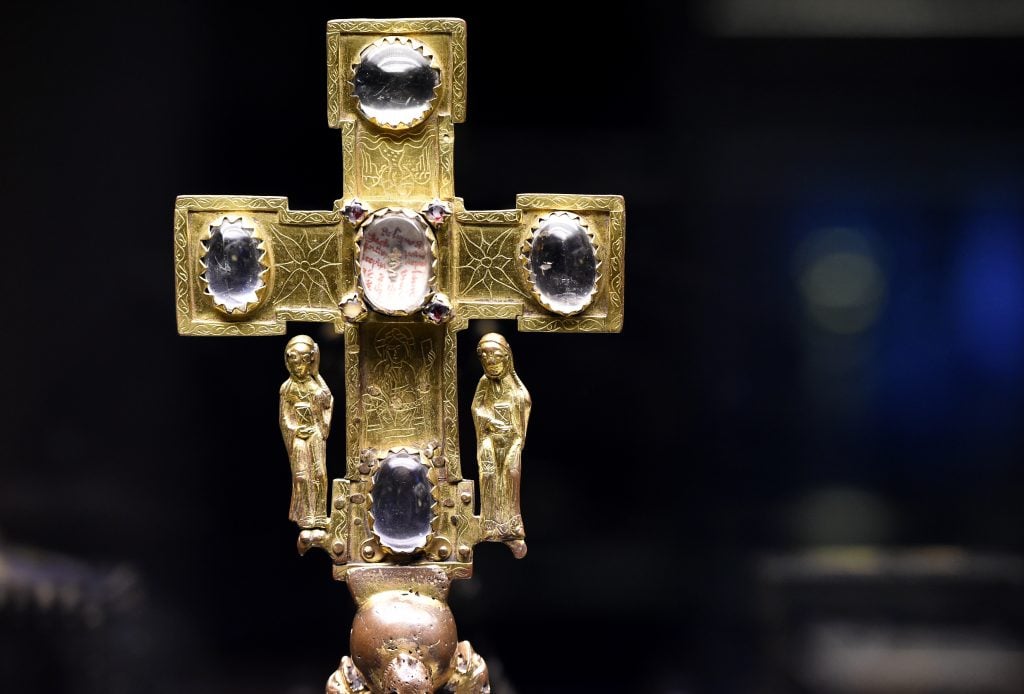Law & Politics
In the US Supreme Court, Germany Fights With Art Dealers’ Heirs Over the Fate of the $250 Million Guelph Treasure
The valuable haul was sold at what the heirs say was a severely discounted price.

The valuable haul was sold at what the heirs say was a severely discounted price.

Sarah Cascone

It’s rare that any art-related case makes its way to the highest court in the United States. But the Supreme Court heard oral arguments yesterday about whether the US can adjudicate a long-running dispute over the Guelph Treasure, a collection of medieval artworks reportedly valued at $250 million that a consortium of Jewish art dealers sold to the Nazis in the 1930s.
The dealers’ heirs claim the transaction was a forced sale, part of a larger pattern of artwork looted by the Nazis during and in the lead-up to the Holocaust.
Up for debate in court this week, however, was not the legality of the sale, but whether the US even has grounds to hear the case against Germany, which had petitioned to have the suit dropped. Under the 1976 Foreign Sovereign Immunities Act, other countries cannot be sued in US court—unless the case falls under the “expropriation exception,” where property was taken “in violation of international law.”
Known as “the law of takings,” this exception allowed refugee Maria Altmann to successfully sue Austria for the return of four Gustav Klimt canvases, including his famed Portrait of Adele Bloch-Bauer (1907). (She sold the work to New York’s Neue Galerie for a then-record $135 million, and the eight-year legal battle inspired a film, Woman in Gold, starring Helen Mirren and Ryan Reynolds.)

Saemy Rosenberg, one of the owners of the Guelph Treasure, and his wife, Lisellotte, with an unnamed man. His grandson, Jed Leiber, is suing Germany for the forced sale of the treasure to the Nazis. Photo courtesy of Jed Leiber.
Alan Philipp, Gerald Stiebel, and Jed Leiber, the heirs of the Guelph Treasure’s former owners, are hoping this exception will allow them to finally reclaim the gold and gem-encrusted artworks from the Prussian Cultural Heritage Foundation (the Stiftung Preussischer Kulturbesitz, or SPK), which runs Berlin’s state museums. The Guelph Treasure, called the Welfenschatz in German, has been on view at Berlin’s Museum of Decorative Arts since 1963.
In the oral arguments, Jonathan M. Freiman, a lawyer for Germany—which has the support of the Trump administration in the case—accused the heirs of “trying to turn this modest exception into a novel tool for suing foreign sovereigns for human rights and law of war violations occurring in their own countries.” He argued that in drafting the 1976 law, “Congress did not see fit to create any kind of exception for genocide claims.”
But Nicolas O’Donnell, representing the heirs, contended that the very nature of the Holocaust fits into the framework of the Foreign Sovereign Immunities Act. “If you take the property, as Germany did, explicitly to destroy the group of people and remove it from the face of the earth, then you’ve committed genocide through the taking of property, which is the focus of the expropriation exception,” he said.
Also at issue was whether the expropriation exception only allows foreign nationals to sue a nation state in the US. Freiman argued that the case involves German art dealers, German art, and the German state, and therefore must be decided by the German courts. (Two of the three heirs, Jed Leiber and Gerald Stiebel, live in the US; the third lives in the UK.)
O’Donnell countered that the exception was specifically created with the Holocaust in mind. Such a reading would imply that “Congress intended to disadvantage the Nazi’s first victims, German Jews,” he said. “This makes no sense.”

The Guelph Treasure displayed at the Kunstgewerbemuseum (Museum of Decorative Arts) in Berlin. Photo: Tobias Schwarz/AFP via Getty Images.
The treasure takes its name from the House of Guelph of Brunswick-Lüneburg and dates to the 11th through 15th centuries. A group of Jewish dealers—Zacharias Hackenbroch, Isaac Rosenbaum, Saemy Rosenberg, and Julius Falk Goldschmidt—bought the 82-piece collection in 1929 for 7.5 million Reichsmark. In 1935, they sold about half of the treasure at a loss to the Prussian state for 4.25 million Reichsmark.
The plaintiffs believe that Nazi leader Hermann Göring gifted the treasure to Adolf Hitler, but the Prussian Cultural Heritage Foundation maintains that its research shows the artworks were purchased for the Prussian state. While the foundation argues that the dealers sold the treasure at a fair market price based on the global economy during the Great Depression, the heirs contend it was worth three times as much.
The dispute migrated to the US court system after legal efforts in Germany failed. A non-binding 2014 ruling from German Advisory Commission on Nazi-looted art found that the sale of the Guelph Treasure was not made under duress.
In 2017, however, a US district judge allowed the case to proceed, finding that the sale “bears a sufficient connection to genocide such that the alleged coerced sale may amount to a… violation of international law.” The Supreme Court agreed to hear the case in July.
Following yesterday’s oral arguments, O’Donnell is “optimistic in the case and the ultimate result,” he told Artnet News. “I thought the justices were engaged in the text of the [Foreign Sovereign Immunities Act] and Congress’s treatment of Nazi-era claims, as we expected. I found their questions about the scope and implications of the law to be thoughtful.”
“We believe that US courts have no jurisdiction over this case,” said Hermann Parzinger, president of the Prussian Cultural Heritage Foundation, in a statement. “In addition to the jurisdictional arguments, we emphasized SPK’s deep commitment to provenance research and to the fair and just resolution of legitimate claims to Nazi-confiscated art, consistent with the Washington Conference Principles that have guided our approach to restitution matters for more than two decades.”
A verdict is expected in June.